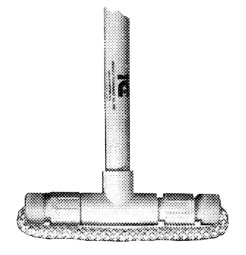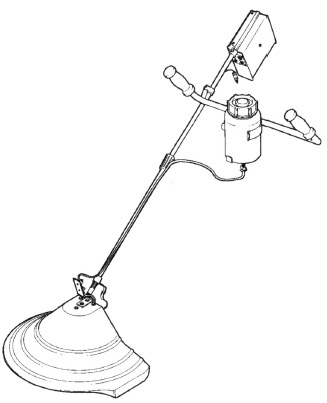Market Search
MTDC searched for ways to make the application of herbicides more efficient and safer. We looked at hooded sprayers, roller/wick applicators, brush and other mechanical weeders, ultralow-volume and controlled-droplet-application sprayers, chemical injection systems, and sensors that could identify chlorophyll. Some benefits we sought included reductions in:
- The size of field crews
- The field crew's exposure to chemicals
- Wasted chemicals
- The time needed to clean equipment
Commercially Available Sprayers
The Egedal sprayer is imported from Denmark by Timm Enterprises. The Augusta Forestry Center purchased one of these units as this project was underway. In January 2000, the price of this Type GS Bed Cultivator with eight-row spray system (figure 1) was about $14,000.

Figure 1—The Egedal sprayer, which is commercially available,
also has mechanical weeding attachments.
Roller/wick applicators (figure 2) were considered because they use less herbicide than sprayers and the spray does not drift. However, roller/wick applicators were dropped from further consideration because they might not eradicate low weeds, such as prostrate spurge, and because mud may accumulate on them.

Figure 2—Spray does not drift when it is applied
with roller/wick
applicators, but the applicators
may become gummed up with mud when weeds
are close
to the ground. —Courtesy of Reddick
Equipment Co., Inc.
Several nurseries use the FOBRO Brush Hoe (imported by Baertschi-FOBRO AG, figure 3). Nursery employees told us that the brush hoe works fairly well in loose soils when weeds are not well established. An optional sprayer attachment is available. The larger of the two models had just 13 inches of clearance for plants, too little for some of the taller hardwood seedlings.

Figure 3—The FOBRO Brush Hoe uses plastic bristles to
gently
remove weeds. The unit also has an optional sprayer.
—Courtesy of Baertschi-FOBRO AG
Spyders, torsion weeders, and spring hoe weeders (figure 4) were investigated. Each requires a specialized weeding tractor that allows the weeding unit to be mounted between its front and rear wheels so the tractor operator Mankarcan see the weeding devices and keep them away from the plants. These weeders are gentler on the plants than weeders that use sweeps and shanks. The tradeoff is that these weeders may not remove all the weeds.

Figure 4—Spyders, torsion weeders, and spring-hoe weeders
typically are more aggressive than weeders that
use
plastic
bristles. Their potential to damage the crop is also greater.
—Illustration by John Gist. Reprinted from Steel in the Field:
A Farmer's Guide to Weed Management Tools with permission
from the Sustainable Agriculture Network (http://www.sare.org).
Ultralow-Volume and Controlled-Droplet-Application Sprayers
Ultralow-volume sprayers, such as the Mankar (figure 5), Herbi, and Herbiflex, typically use shrouded spinning discs that are designed for controlled-droplet application of herbicides in narrow bands. Some units like the Mankar can apply undiluted Roundup. The Vegedome by BUBCO (figure 6) claims to reduce the amount of water used by 80 to 90 percent and to reduce the amount of herbicide used by 50 percent. Commercially available units have been mounted under hoods and used on all-terrain-vehicle sprayers. These sprayers claim to apply herbicide more efficiently.

Figure 5—The Mankar ultralow-volume controlled-droplet-application
sprayer.—Courtesy of Superb Horticulture/Mankarcan

Figure 6—The controlled-droplet-application system in
the Vegedome sprayer by BUBCO uses a spinning-disc
rotary atomizer to produce optimum-size spray droplets
that
are evenly distributed. This system allows low-
pressure, low-volume application, minimizing chemical
waste and environmental contamination, and extending
the time a tank of herbicide can be used between refills.
—Courtesy of BUBCO, In

